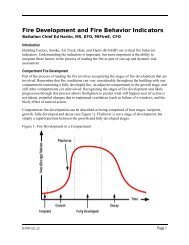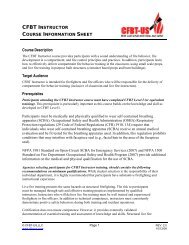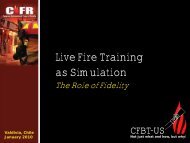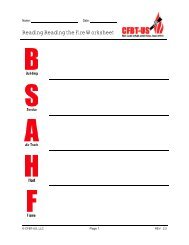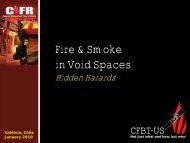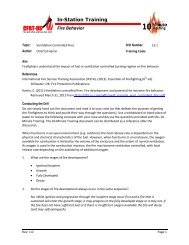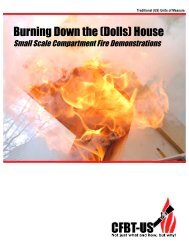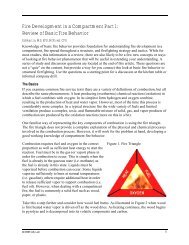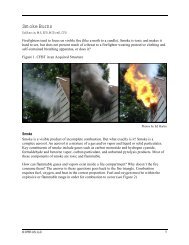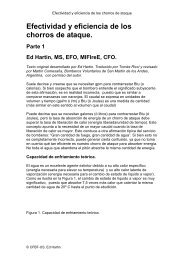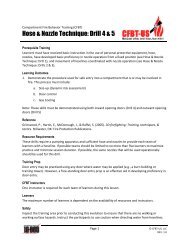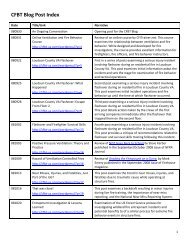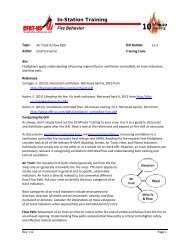Hose & Nozzle Technique Drill 2: Maneuver and - CFBT-US!
Hose & Nozzle Technique Drill 2: Maneuver and - CFBT-US!
Hose & Nozzle Technique Drill 2: Maneuver and - CFBT-US!
Create successful ePaper yourself
Turn your PDF publications into a flip-book with our unique Google optimized e-Paper software.
HOSE AND NOZZLE TECHNIQUE DRILL 2<br />
Personal Protective Equipment<br />
Learners should wear structural firefighting clothing <strong>and</strong> self-contained breathing apparatus during this<br />
drill. However, in hot weather session duration should be limited.<br />
Scene Control<br />
Scene control will vary to some extent based on the specific training location. The immediate training<br />
area will be limited to participants <strong>and</strong> (accompanied) observers of the training activity.<br />
If in-service apparatus is at the training location, position it to ensure ease of egress.<br />
Instructional Activities<br />
This lesson involves the following instructional activities. Base your instructional approach on learners<br />
experience level <strong>and</strong> underst<strong>and</strong>ing as the lesson progresses.<br />
Firefighters often perceive that gas cooling will slow advancement of the hoseline (based on the<br />
perceived need to stop <strong>and</strong> apply water before advancing). However, a skilled nozzle operator can<br />
generally apply short pulses while moving. Long pulses as needed to deal with larger spaces or more<br />
severe fire conditions will generally require the hose team to stop, apply water, <strong>and</strong> assess conditions<br />
before advancing.<br />
1. Provide a quick review of nozzle technique <strong>and</strong> the skills that learners will be practicing.<br />
a. Short Pulse: Have the learners imagine opening <strong>and</strong> closing the nozzle as quickly as<br />
possible. Then tell them that the short pulse is slightly quicker than that (to emphasize<br />
that this needs to be an extremely short application of water). Water hammer is not an<br />
issue due to the minimal duration of the pulse <strong>and</strong> small amount of water involved.<br />
b. Long Pulse: A long pulse is anything longer than a short pulse. The duration of long<br />
pulses is dependent on compartment configuration <strong>and</strong> fire conditions. In practicing this<br />
skill, learners should apply pulses from several seconds up to 15 or 20 seconds. The long<br />
pulse requires that the nozzle be opened quickly (to provide maximum pressure <strong>and</strong><br />
obtain the desired droplet size) <strong>and</strong> closed relatively slowly (to minimize potential for<br />
water hammer).<br />
c. Painting: Developing a thin film of water on a hot surface requires gentle application.<br />
This requires opening the nozzle only enough for water to reach the intended target.<br />
Overly vigorous application results in water bouncing off <strong>and</strong> not cooling the intended<br />
surface.<br />
d. Penciling: Penciling is similar to pulsing (short or long), but with a straight stream. This<br />
technique is used to maximize reach when applying water to hot surfaces. Brief<br />
application uses the same quick operation of the nozzle shutoff as a short pulse, longer<br />
application requires quick opening <strong>and</strong> slower closing of the shutoff in the same manner<br />
as a long pulse.<br />
2. Demonstrate the position of the nozzle operator <strong>and</strong> other members of the hose team when<br />
working with a charged hoseline. The number of personnel used should reflect the learners’<br />
operational reality (e.g., don’t use three or four firefighters on a hoseline if they will typically<br />
operate with two).<br />
Page 2 © <strong>CFBT</strong>-<strong>US</strong>, LLC<br />
REV: 1.0




